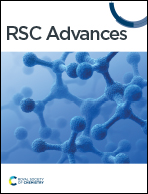Aminocyclopropenium as a novel hydrogen bonding organocatalyst for cycloaddition of carbon disulfide and epoxide to prepare cyclic dithiocarbonate†
Abstract
The smallest Hückel aromatic ring cyclopropenium substituted by electron-donating C-amino groups produced a aminocyclopropenium electron-rich cation. A bifunctional aminocyclopropenium halide catalyst installed with bis-(hydroxyethyl) functions on the amino group was then designed. A typical (diethanolamino)cyclopropenium halide catalyst C5·I was screened optimally for the cycloaddition of carbon disulfide into an epoxide to produce cyclic dithiocarbonate with an excellent conversion (95%) and high selectivity (92%). The electrostatic enhancement of alkyl C–H HBD capability was implemented via vicinal positive charges on the cyclopropenium core, and the acidity of the terminal O–H hydrogen proton increased by intramolecular H-bonding between the two hydroxy groups on the diethanolamino group (O–H⋯O–H). Then, a hybrid H-bond donor comprising enhanced alkyl C–H and hydroxy O–H was formed. The hybrid HBD offered by aminocyclopropenium was vital in activating the epoxide and stabilizing the intermediate, resulting in reduced O/S scrambling. Moreover, weakly coordinated iodide anion served as a nucleophilic reagent to open the ring of the epoxide. The cooperative catalytic mechanism of the HBD cation and halide anion was supported by NMR titrations and control experiments. Eleven epoxides with various substituents were converted into the corresponding cyclic thiocarbonate with high conversion and selectivity under mild conditions (25 °C, 6 h) without a solvent. The cycloaddition of carbon disulfide with epoxides catalyzed by aminocyclopropenium developed a new working model for hydrogen bonding organocatalysis.



 Please wait while we load your content...
Please wait while we load your content...